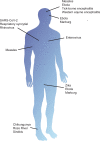Why does viral RNA sometimes persist after recovery from acute infections?
- PMID: 35648781
- PMCID: PMC9191737
- DOI: 10.1371/journal.pbio.3001687
Why does viral RNA sometimes persist after recovery from acute infections?
Abstract
DNA viruses often persist in the body of their host, becoming latent and recurring many months or years later. By contrast, most RNA viruses cause acute infections that are cleared from the host as they lack the mechanisms to persist. However, it is becoming clear that viral RNA can persist after clinical recovery and elimination of detectable infectious virus. This persistence can either be asymptomatic or associated with late progressive disease or nonspecific lingering symptoms, such as may be the case following infection with Ebola or Severe Acute Respiratory Syndrome Coronavirus 2 (SARS-CoV-2). Why does viral RNA sometimes persist after recovery from an acute infection? Where does the RNA come from? And what are the consequences?
Conflict of interest statement
I have read the journal’s policy and the author of this manuscript has the following competing interests: Membership on advisory boards for Takeda Pharmaceuticals, GreenLight Bioscience, GlaxoSmithKline, Academia Sinica, University of Maryland and University of Vermont; Funding from Gilead, MeVox and the US National Institutes of Health.
Figures



Similar articles
-
Coronavirus persistence in human respiratory tract and cell culture: An overview.Braz J Infect Dis. 2021 Sep-Oct;25(5):101632. doi: 10.1016/j.bjid.2021.101632. Epub 2021 Oct 2. Braz J Infect Dis. 2021. PMID: 34627782 Free PMC article. Review.
-
Ocular Pathology and Occasionally Detectable Intraocular Severe Acute Respiratory Syndrome Coronavirus-2 RNA in Five Fatal Coronavirus Disease-19 Cases.Ophthalmic Res. 2021;64(5):785-792. doi: 10.1159/000514573. Epub 2021 Jan 20. Ophthalmic Res. 2021. PMID: 33472206
-
Persistent viral RNA positivity during the recovery period of a patient with SARS-CoV-2 infection.J Med Virol. 2020 Sep;92(9):1681-1683. doi: 10.1002/jmv.25940. Epub 2020 Jun 2. J Med Virol. 2020. PMID: 32330293 Free PMC article.
-
Inference of Active Viral Replication in Cases with Sustained Positive Reverse Transcription-PCR Results for SARS-CoV-2.J Clin Microbiol. 2021 Jan 21;59(2):e02277-20. doi: 10.1128/JCM.02277-20. Print 2021 Jan 21. J Clin Microbiol. 2021. PMID: 33239378 Free PMC article.
-
Viral persistence in children infected with SARS-CoV-2: current evidence and future research strategies.Lancet Microbe. 2023 Sep;4(9):e745-e756. doi: 10.1016/S2666-5247(23)00115-5. Epub 2023 Jun 26. Lancet Microbe. 2023. PMID: 37385286 Free PMC article. Review.
Cited by
-
Zika virus-induced fetal demise is driven by strain- and dose-specific RLR-driven activation of the interferon response in the decidua, placenta, and fetus in Ifnar1 -/- mice.bioRxiv [Preprint]. 2025 Feb 13:2025.02.12.637947. doi: 10.1101/2025.02.12.637947. bioRxiv. 2025. Update in: J Virol. 2025 Jun 17;99(6):e0066625. doi: 10.1128/jvi.00666-25. PMID: 39990459 Free PMC article. Updated. Preprint.
-
Core features and inherent diversity of post-acute infection syndromes.Front Immunol. 2025 Jun 3;16:1509131. doi: 10.3389/fimmu.2025.1509131. eCollection 2025. Front Immunol. 2025. PMID: 40529374 Free PMC article. Review.
-
The oral drug obeldesivir protects nonhuman primates against lethal Ebola virus infection.Sci Adv. 2025 Mar 14;11(11):eadw0659. doi: 10.1126/sciadv.adw0659. Epub 2025 Mar 14. Sci Adv. 2025. PMID: 40085692 Free PMC article.
-
Clinical Follow-Up and Postmortem Findings in a Cat That Was Cured of Feline Infectious Peritonitis with an Oral Antiviral Drug Containing GS-441524.Viruses. 2022 Sep 14;14(9):2040. doi: 10.3390/v14092040. Viruses. 2022. PMID: 36146845 Free PMC article.
-
Exploring extracellular vesicles as mediators of clinical disease and vehicles for viral therapeutics: Insights from the COVID-19 pandemic.Extracell Vesicles Circ Nucl Acids. 2022;3(3):172-188. doi: 10.20517/evcna.2022.19. Epub 2022 Jul 19. Extracell Vesicles Circ Nucl Acids. 2022. PMID: 35929616 Free PMC article.
References
-
- Anderson RM, Medley GF. Epidemiology of HIV infection and AIDS: incubation and infectious periods, survival and vertical transmission. AIDS. 1988;2(Suppl 1):S57–63. - PubMed
-
- Lyles RH, Munoz A, Yamashita TE, Bazmi H, Detels R, Rinaldo CR, et al.. Natural history of human immunodeficiency virus type 1 viremia after seroconversion and proximal to AIDS in a large cohort of homosexual men. Multicenter AIDS Cohort Study. J Infect Dis. 2000;181(3):872–80. doi: 10.1086/315339 - DOI - PubMed
Publication types
MeSH terms
Substances
Grants and funding
LinkOut - more resources
Full Text Sources
Medical
Miscellaneous

